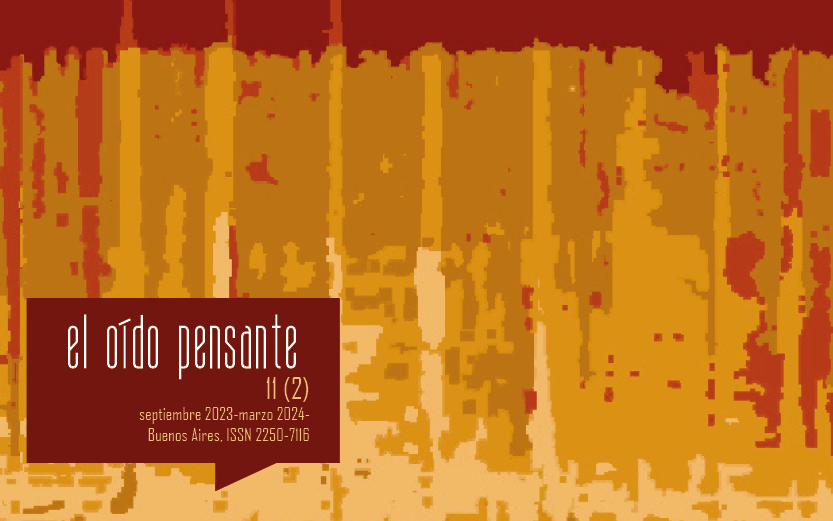Transgresiones neoliberales en la industria cinematográfica contemporánea: música clásica y cuerpos musicales deshumanizados en las películas The Perfection (2018) y Nocturne (2020)
Resumen
El objetivo de este artículo es examinar lo que llamo “cuerpos musicales deshumanizados” en las películas de terror psicológico The Perfection y Nocturne. Estos cuerpos neoliberales multideficientes están expuestos a la imagen estereotipada y sorprendentemente negativa del sofisticado mundo del arte. Se presta especial atención al tratamiento provocador de la música clásica, centrándose en las prácticas institucionales no normativas y la reconfiguración ética de sus representantes. Una forma sorprendentemente cruda de deshumanización musical se encuentra en la película The Perfection, cuya banda sonora combina sonidos ambientales de terror y melodías populares con grandes obras clásicas de Handel, Mozart y Casadesus. La película Nocturne, en cambio, ofrece una estética audiovisual más contemplativa con una jerarquización engañosa del repertorio de música clásica. La música de Mozart se devalúa caprichosamente, mientras que el “Concierto para piano No. 2 en sol menor”” de Saint-Saëns se utiliza como recurso narrativo para una manifestación destructiva de poder que conduce a una avalancha de conflictos entre las hermanas. Este juego explícito con significantes de la música clásica se desvía drásticamente de los protocolos musicales convencionales y conduce a la alienación y, en última instancia, a la deshumanización neoliberal transgresora de los músicos contemporáneos.Descargas
Citas
Adorno, T. W. (1976). Introduction to the Sociology of Music. New York: The Seabury Press.
Adorno, T. W. (1991 [1938]). On the Fetish Character in Music and the Regression of Listening. In J. M. Bernstein (Ed.). The Culture Industry. Selected Essays on Mass Culture (pp. 29-60). London: Routledge.
Adorno, T. W. (2002 [1941]). The Radio Symphony. In R. Leppert (Ed.). Essays on Music (pp. 251-270). Berkeley: University of California Press.
Attali, J. (1985 [1977]). Noise: The Political Economy of Music. Minneapolis: University of Minnesota Press.
Benjamin, W. (1997 [1968]). Theses on the Philosophy of History. In H. Zohn (Trans.). Illuminations: Essays and Reflections (pp. 253-265). New York: Schocken Books.
Bordwell, D. and Thompson, K. (2010). Film Art: An Introduction, 9th edition. New York: McGraw-Hill.
Bourdieu, P. (1984 [1979]). Distinction: A Social Critique of the Judgement of Taste. Cambridge: Harvard University Press.
Brown, W. (2015). Undoing the Demos: Neoliberalism’s Stealth Revolution. Cambridge, Mass: Zone Books, MIT Press.
Buhler, J. (2022). Composing for the Films in the Age of Digital Media. In G. Borio (Ed.). The Mediations of Music: Critical Approaches after Adorno (pp. 144-163). London and New York: Routledge. Doi: https://doi.org/10.4324/9781003166139-12
Buhler, J., Neumeyer, D. and Deemer, R. (2010). Hearing the Movies: Music and Sound in Film History. Oxford: Oxford University Press,
Buljančević, R. (2021). Ideological Aspects of Erotic Capital and Patriarchal Power Relations in the Visual Interpretations of Lola Astanova. New Sound International Journal of Music, 58(2), 98-116. https://doi.org/10.5937/newso2158098B
Buljančević, R. (2022a). Between Tradition and Subversion. Treatment of Folklorised Musical References in the Early Feature Films of Pedro Almodóvar. Muzikologija, 32, 161-181. Doi: https://doi.org/10.2298/MUZ2232161B
Buljančević, R. (2022b). Music in Pasolini’s The Decameron: Humour, Spirituality, (De)tabooisation and Playing with Conventional Signifiers of the Italian Musical Past. Zbornik Akademije umetnosti, 10, 130-155. Doi: https://doi.org/10.5937/ZbAkU2210130B
_____. Film, Music, and Migrant Identities: Representing Musical Otherness in Visconti’s Neorealist Drama Rocco and His Brothers. Resonancias, 27(52): 129-156. Doi: http://doi.org/10.7764/res.2023.52.7
Burke, E. (1990 [1759]). A Philosophical Enquiry into the Origin of our Ideas of the Sublime and Beautiful. New York: Oxford University Press.
Cormack, M. (2006). The Pleasures of Ambiguity: Using Classical Music Melodrama in Film. In P. Powrie and R. Stilwell (Eds.). Changing Tunes: The Use of Pre-Existing Music in Film (pp. 19-30). Aldershot: Ashgate.
De Clercq, R. (2011). Aesthetic Properties. In T. Gracyk and A. Kania (Eds.). Routledge Companion to Philosophy and Music (pp. 144-155). London: Routledge.
Fabbri, F. (2008). La escucha tabú. In M. García Quiñone (Ed.). La música que no se escucha: aproximaciones a la escucha ambiental (pp. 17-37). Barcelona: Orquestra del Caos.
Foucault, M. (1975). Surveiller et punir. Paris: Gallimard.
Foucault, M. (1980) “The Confession of the Flesh”. In C. Gordon (Ed.). Power/Knowledge: Selected Interviews and Other Writings 1972–1977 (pp. 194-228). Brighton: Harvester Press.
Fry, K. (2008). Elaboration, Counterpoint, Transgression: Music and the Role of the Aesthetic in the Criticism of Edward W. Said. Paragraph, 31(3), 265-279. Doi: https://doi.org/10.3366/E0264833408000278
Giroux, H. A. (2010). Neoliberalism, Pedagogy, and Cultural Politics: Beyond the Theatre of Cruelty. In L. Zeus (Ed.). Handbook of Cultural Politics and Education (pp. 49-70). Rotterdam: Sense Publishers.
Gorbman, C. (1987). Unheard Melodies: Narrative Film Music. Bloomington: Indiana University Press.
Greig, D. (2022). ‘Somewhat of an Affectation’: Bach, Vivaldi, and the Early Films of Pier Paolo Pasolini. Music and Letters, 103(1), 116-149. Doi: https://doi.org/10.1093/ml/gcab062
Halfyard, J. K. (2006). Screen Playing: Cinematic Representations of Classical Music Performance and European Identity. In M. Mera and D. Burnand (Eds.). European Film Music (pp. 73-85). Hampshire & Burlington: Ashgate Publishing Limited.
Harjunen, H. (2017). Neoliberal Bodies and the Gendered Fat Body. London and New York: Routledge.
Heldt, G. (2013). Music and Levels of Narration in Film: Steps across the Border. Bristol and Chicago: Intellect.
Huckvale, D. (2022). The Piano on Film. Jefferson: McFarald & Company, Inc.
James, R. (2019). The Sonic Episteme: Acoustic Resonance, Neoliberalism, and Biopolitics. Durham: Duke University Press.
Kramer, L. (2007). Why Classical Music Still Matters. Berkeley and Los Angeles: University of California Press.
Lowe, M. (2007). Pleasure and Meaning in the Classical Symphony. Bloomington: Indiana University Press.
Marcuse, H. (2002 [1964]). One Dimensional Man: Studies in the Ideology of Advanced Industrial Society. London and New York: Routledge.
McIver Lopes, D. (2022). How to Think about How to Think about Aesthetic Value. Journal of Aesthetics & Culture, 14(1), 1-9. Doi: https://doi.org/10.1080/20004214.2021.2010912
Ortega y Gasset, J. (1968 [1925]). The Dehumanization of Art and Other Essays on Art, Culture, and Literature. Princeton: Princeton University Press.
Pontara, T. (2021). Art Music, Perfection and Power: Critical Encounters with Classical Music Culture in Contemporary Cinema. Open Library of Humanities, 7(2), 1-25. Doi: https://doi.org/10.16995/olh.4675
Pope, A. (2006 [1728]). Peri Bathous, or the Art of Sinking in Poetry. In P. Rogers (Ed.). Alexander Pope: The Major Works (pp. 195-239). Oxford: Oxford University Press.
Ritchey, M. (2019). Composing Capital: Classical Music in the Neoliberal Era. Chicago: University of Chicago Press.
Said, E. W. (1991). Musical Elaborations. New York: Columbia University Press.
Schwarm, B. (2014). The Devil’s Trill. Encyclopedia Britannica. Retrieved from https://www.britannica.com/topic/The-Devils-Trill
Schwartz, J. M. (2019). Resisting the Norming of the Neoliberal Academic Subject: Building Resistance [a]cross Faculty Ranks. In C. Manathunga and D. Bottrell (Eds.). Resisting Neoliberalism in Higher Education Volume II: Prising Open the Cracks (pp. 65-88). Cham: Palgrave Macmillan.
Smith, D. L. (2014). Dehumanization, Essentialism, and Moral Psychology. Philosophy Compass, 9, 814-824. Doi: https://doi.org/10.1111/phc3.12174
Smith, D. L. (2016). Paradoxes of Dehumanization. Social Theory and Practice, 42(2), 416-443. Doi: https://doi.org/10.5840/soctheorpract201642222
Stilwell, R. J. (2007). The Fantastical Gap between Diegetic and Nondiegetic. In D. Goldmark, L. Kramer and R. Leppert (Eds.). Beyond the Soundtrack: Representing Music in Cinema (pp. 184-202). Berkeley, Los Angeles and London: University of California Press.
Varkøy, Ø. (2016). Pierre Bourdieu and the Autonomy of Art: The Idea of Art as Critique. In P. Burnard and Y. Hofvander Trulsson (Eds.). Bourdieu and the Sociology of Music Education (pp. 143-159). New York: Routledge.
Winkler, M. (1951). A Penny from Heaven. New York: Appleton-Century-Crofts.
Filmography
Chazelle, D. (2015 [2014]). [Dir.]. Whiplash. DVD. Culver City, CA: Sony Pictures.
Haneke, M. (2002 [2001]). [Dir.]. La Pianiste. DVD. New York: Kino International Corp.
Polanski, R. (2003 [2002]). [Dir.]. The Pianist. DVD. Australia: Universal Pictures.
Quirke, Z. (2020). [Dir.]. Nocturne. US: Amazon Studios. Retrieved from https://www.amazon.com/Nocturne-Sydney-Sweeney/dp/B08DXBQCPY
Shepard, R. (2019 [2018]). [Dir.]. The Perfection. DVD. Los Gatos, CA: Netflix.























